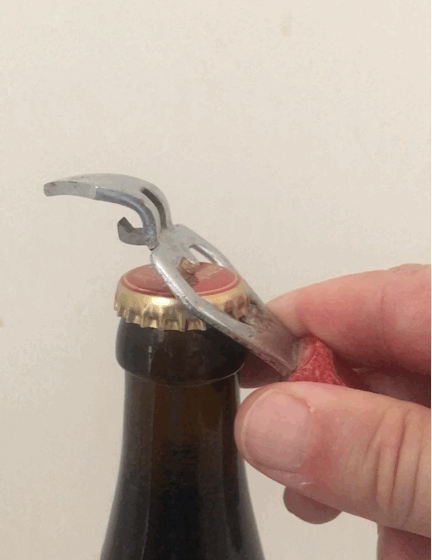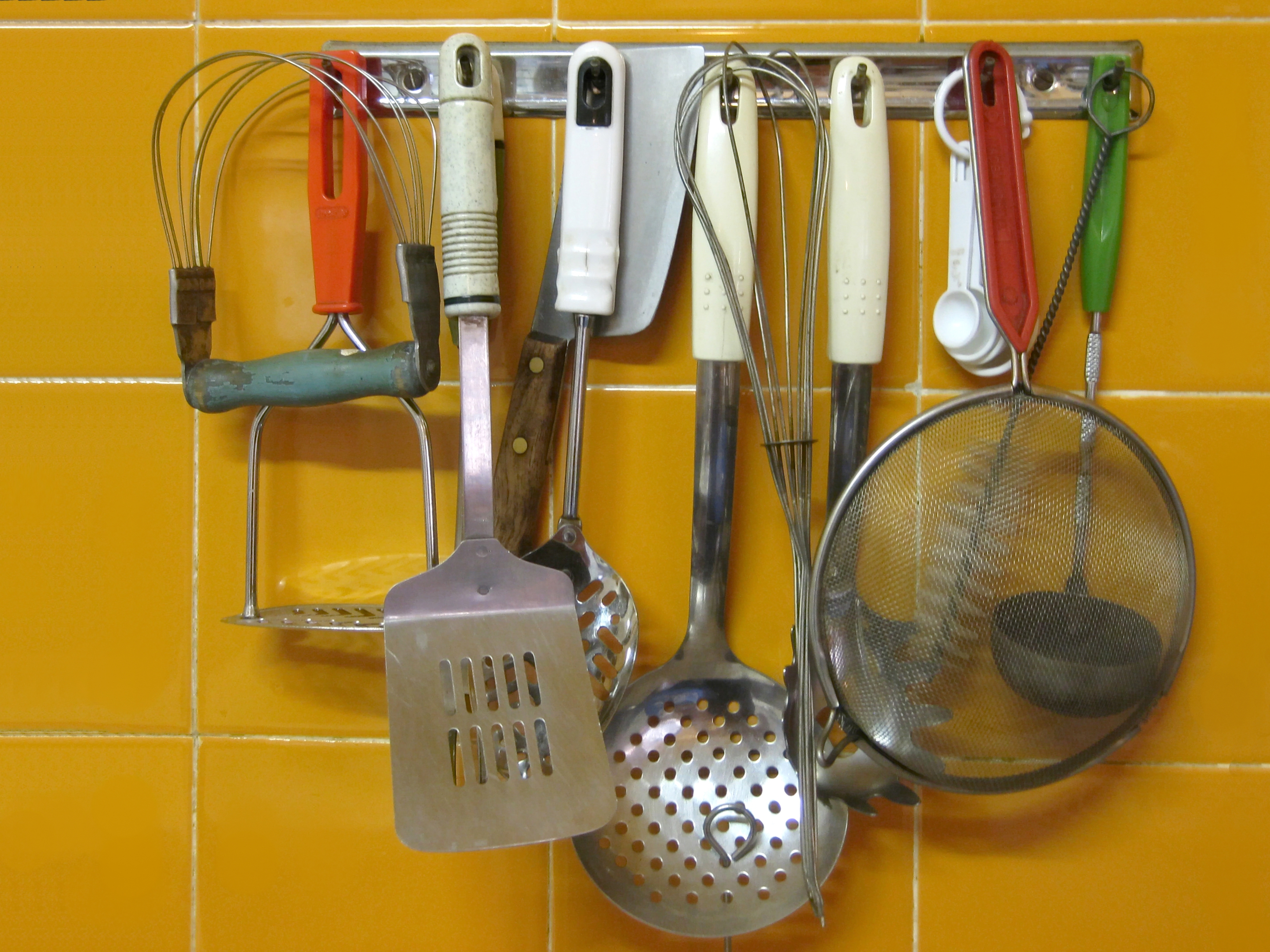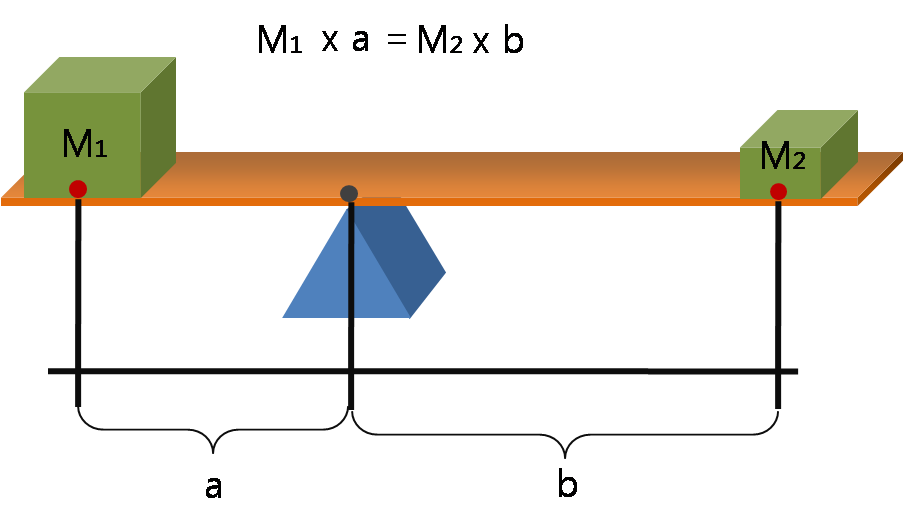|
Bottle-opener
A bottle opener is a device that enables the removal of metal bottle caps from glass bottles. More generally, it might be thought to include corkscrews used to remove cork or plastic stoppers from wine bottles. A metal bottle cap is affixed to the rim of the neck of a bottle by being pleated or ruffled around the rim. A bottle opener is a specialized lever inserted beneath the pleated metalwork, which uses a point on the bottle cap as a fulcrum on which to pivot. History Invention of the bottle opener is credited to William Painter, who receive a patent on the crown cork bottle cap in 1892, and a patent on the first bottle opener (then called a "bottle cap lifter") in 1894. Varieties There are several distinct designs of such bottle openers. Wall mounted openers are typically found behind bars in pubs, whilst hand-tool bottle openers tend to be found and used in domestic environments. The functional elements of bottle openers (a tooth or lip to catch the underside of the cap ... [...More Info...] [...Related Items...] OR: [Wikipedia] [Google] [Baidu] |
Beverage Opener
A beverage opener (also known as a multi-opener) is a device used to open beverage cans, plastic bottles or glass bottles, which are the three most common beverage containers. Types Beverage openers vary in size but commonly include a glass bottle crown cork remover, glass bottle threaded metal crown cork cap grip for greater twisting torque, a plastic bottle cap grip for greater twisting torque and a stay tab lever for metal beverage cans. Some openers have extra conveniences built in such as magnetic backing to catch and hold metal caps or stick to a refrigerator door. They may be standalone devices or be incorporated into can openers. Benefits Beverage openers are useful for opening everyday beverage containers for those who have limited hand strength as it eliminates the need for strong twisting or pulling motions. Plastic bottles may become stuck due to a high volume of carbonation released during shipping or overtightening. Some do not have fingernails with which to p ... [...More Info...] [...Related Items...] OR: [Wikipedia] [Google] [Baidu] |
Crown Cap
The crown cork (also known as a crown seal, crown cap or just a cap), the first form of bottle cap, was invented by William Painter in 1892 in Baltimore. The company making it was originally called the Bottle Seal Company, but it changed its name with the almost immediate success of the crown cork to the ''Crown Cork and Seal Company''. It still informally goes by that name, but is officially Crown Holdings. Overview A Dutch patent application from 1892 This style of closure is still in widespread use. Prior to the invention of the external crown cork bottle stopper, soda bottles had ordinary internal cork bottle stoppers and often had rounded bottoms so they could not be stored standing upright. Corks have a tendency to dry out and shrink, allowing the gas pressure in the bottle to cause the cork to "pop", so bottles were stored on their side to prevent the corks from drying out. After the invention of the crown cork bottle stopper, this problem was eliminated, and sod ... [...More Info...] [...Related Items...] OR: [Wikipedia] [Google] [Baidu] |
Canada
Canada is a country in North America. Its Provinces and territories of Canada, ten provinces and three territories extend from the Atlantic Ocean to the Pacific Ocean and northward into the Arctic Ocean, making it the world's List of countries and dependencies by area, second-largest country by total area, with the List of countries by length of coastline, world's longest coastline. Its Canada–United States border, border with the United States is the world's longest international land border. The country is characterized by a wide range of both Temperature in Canada, meteorologic and Geography of Canada, geological regions. With Population of Canada, a population of over 41million people, it has widely varying population densities, with the majority residing in List of the largest population centres in Canada, urban areas and large areas of the country being sparsely populated. Canada's capital is Ottawa and List of census metropolitan areas and agglomerations in Canada, ... [...More Info...] [...Related Items...] OR: [Wikipedia] [Google] [Baidu] |
Food Preparation Utensils
A kitchen utensil is a hand-held, typically small tool that is designed for food-related functions. Food preparation utensils are a specific type of kitchen utensil, designed for use in the preparation of food. Some utensils are both food preparation utensils and eating utensils; for instance some implements of cutlery – especially knives – can be used for both food preparation in a kitchen and as eating utensils when dining (though most types of knives used in kitchens are unsuitable for use on the dining table). In the Western world, utensil invention accelerated in the 19th and 20th centuries. It was fuelled in part by the emergence of technologies such as the kitchen stove and refrigerator, but also by a desire to save time in the kitchen, in response to the demands of modern lifestyles. Cornell Un ... [...More Info...] [...Related Items...] OR: [Wikipedia] [Google] [Baidu] |
Bottles
A bottle is a narrow-necked container made of an impermeable material (such as glass, plastic or aluminium) in various shapes and sizes that stores and transports liquids. Its mouth, at the bottling line, can be sealed with an internal stopper, an external bottle cap, a closure, or induction sealing. Etymology First attested in 14th century. From the English word ''bottle'' derives from an Old French word ''boteille'', from vulgar Latin">-4; we might wonder whether there's a point at which it's appropriate to talk of the beginnings of French, that is, when it wa ... word ''boteille'', from vulgar Latin ''butticula'', from late Latin ''buttis'' ("cask"), a Latinisation (literature), latinisation of the Greek language, Greek βοῦττις (''bouttis'') ("vessel"). Types Glass Wine The glass bottle represented an important development in the history of wine, because, when combined with a high-quality stopper such as a cork, it allowed long-term aging of wine. Gl ... [...More Info...] [...Related Items...] OR: [Wikipedia] [Google] [Baidu] |
Jar Opener
A jar opener is a kitchen device which is used to open glass or plastic jars. A jar is sealed by either (a) a Screw cap, screw-off rubberised lid or (b) a lid placed on the opening of the jar with a rubber sealing-ring between. Screw-off lids are usually made of metal with a thin rubber sealing layer, whereas lift-off lids mostly consist of glass. Types Screw-off lids A traditional jar opener for a screw-off lid will have two handles, leading up to two concentric grooved rings which can be used to fit different lids. It also sometimes has a device to open a bottle on it. There are many models including rubber sheet grip models and rubber timing belt loop models. Lift-off lids Jar openers that are designed to wedge open a lid sealed by a rubber ring were patented and produced in Germany in the mid 1930s, but all production has halted following the turn of the century. On the right is an example of a wooden vintage jar opener for preserve jars. Reasons for use Many people can ... [...More Info...] [...Related Items...] OR: [Wikipedia] [Google] [Baidu] |
Accident Compensation Corporation
The Accident Compensation Corporation (ACC) () is the New Zealand Crown entity responsible for administering the country's No-fault insurance, no-fault accidental injury compensation scheme, commonly referred to as the ACC scheme. The scheme provides financial compensation and support to citizens, residents, and temporary visitors who have suffered personal injuries. The corporation was founded as the Accident Compensation Commission on 1 April 1974 as a result of the Accident Compensation Act 1972. Its principal governing act today is the Accident Compensation Act 2001. As a Crown entity, ACC is governed by a board that is responsible to the Minister for ACC. Unlike most other Crown entities, it has its own dedicated ministerial portfolio, which since February 2025 has been held by Scott Simpson (politician), Scott Simpson. History The ACC has its origins in the Workers' Compensation for Accidents Act 1900, which established a limited compensation scheme for workers who had suf ... [...More Info...] [...Related Items...] OR: [Wikipedia] [Google] [Baidu] |
Obtuse Angle
In Euclidean geometry, an angle can refer to a number of concepts relating to the intersection of two straight lines at a point. Formally, an angle is a figure lying in a plane formed by two rays, called the '' sides'' of the angle, sharing a common endpoint, called the '' vertex'' of the angle. More generally angles are also formed wherever two lines, rays or line segments come together, such as at the corners of triangles and other polygons. An angle can be considered as the region of the plane bounded by the sides. Angles can also be formed by the intersection of two planes or by two intersecting curves, in which case the rays lying tangent to each curve at the point of intersection define the angle. The term ''angle'' is also used for the size, magnitude or quantity of these types of geometric figures and in this context an angle consists of a number and unit of measurement. Angular measure or measure of angle are sometimes used to distinguish between the measurement an ... [...More Info...] [...Related Items...] OR: [Wikipedia] [Google] [Baidu] |
First-class Lever
A lever is a simple machine consisting of a beam or rigid rod pivoted at a fixed hinge, or ''fulcrum''. A lever is a rigid body capable of rotating on a point on itself. On the basis of the locations of fulcrum, load, and effort, the lever is divided into three types. It is one of the six simple machines identified by Renaissance scientists. A lever amplifies an input force to provide a greater output force, which is said to provide leverage, which is mechanical advantage gained in the system, equal to the ratio of the output force to the input force. As such, the lever is a mechanical advantage device, trading off force against movement. Etymology The word "lever" entered English around 1300 from . This sprang from the stem of the verb ''lever'', meaning "to raise". The verb, in turn, goes back to , itself from the adjective ''levis'', meaning "light" (as in "not heavy"). The word's primary origin is the Proto-Indo-European stem , meaning "light", "easy", or "nimble", among o ... [...More Info...] [...Related Items...] OR: [Wikipedia] [Google] [Baidu] |
Vending Machines
A vending machine is an automated machine that dispenses items such as snacks, beverages, cigarettes, and lottery tickets to consumers after cash, a credit card, or other forms of payment are inserted into the machine or payment is otherwise made. The first modern vending machines were developed in England in the early 1880s and dispensed postcards. Vending machines exist in many countries and, in more recent times, specialized vending machines that provide less common products compared to traditional vending machine items have been created. History The earliest known reference to a vending machine is in the work of Hero of Alexandria, an engineer and mathematician in first-century Roman Egypt. His machine accepted a coin and then dispensed wine or holy water. When the coin was deposited, it fell upon a pan attached to a lever. The lever opened a valve which let some water flow out. The pan continued to tilt with the weight of the coin until it fell off, at which point a count ... [...More Info...] [...Related Items...] OR: [Wikipedia] [Google] [Baidu] |
Magnetic Bottle Opener
Magnetism is the class of physical attributes that occur through a magnetic field, which allows objects to attract or repel each other. Because both electric currents and magnetic moments of elementary particles give rise to a magnetic field, magnetism is one of two aspects of electromagnetism. The most familiar effects occur in ferromagnetic materials, which are strongly attracted by magnetic fields and can be magnetized to become permanent magnets, producing magnetic fields themselves. Demagnetizing a magnet is also possible. Only a few substances are ferromagnetic; the most common ones are iron, cobalt, nickel, and their alloys. All substances exhibit some type of magnetism. Magnetic materials are classified according to their bulk susceptibility. Ferromagnetism is responsible for most of the effects of magnetism encountered in everyday life, but there are actually several types of magnetism. Paramagnetic substances, such as aluminium and oxygen, are weakly attracted to an a ... [...More Info...] [...Related Items...] OR: [Wikipedia] [Google] [Baidu] |






